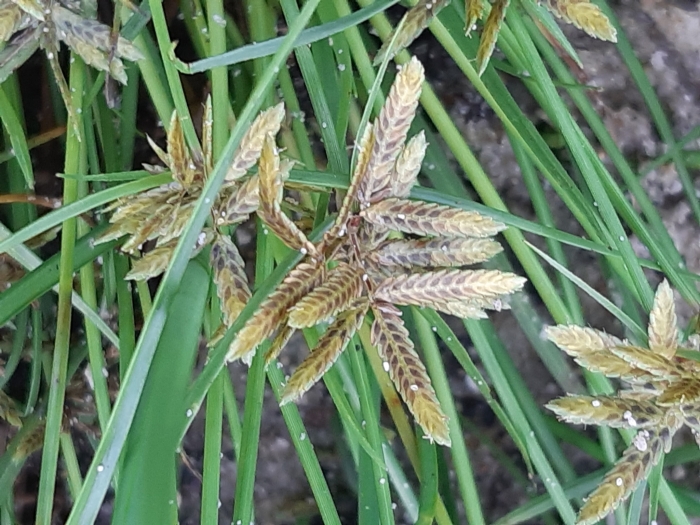Tall Flatsedge
(Cyperus eragrostis)
Tall Flatsedge (Cyperus eragrostis)
/
/

© Catherine Faber
CC BY 4.0
Image By:
© Catherine Faber
Recorded By:
Copyright:
CC BY 4.0
Copyright Notice:
Photo by: © Catherine Faber | License Type: CC BY 4.0 | License URL: http://creativecommons.org/licenses/by/4.0/ | Uploader: fabca121 | Publisher: iNaturalist |









Estimated Native Range
Summary
Cyperus eragrostis, commonly known as tall flatsedge, is a herbaceous perennial plant native to wetlands, marshes, and along the banks of water bodies in the West Coast and parts of Southeastern United States, Jamaica, and South America. It has a clumping growth habit with tall, erect stems that can reach up to 35 inches in height. The plant produces greenish-brown flower clusters at the tops of the stems during late summer to fall, which are not particularly showy but have a unique architectural quality.
Tall flatsedge is valued for its ability to stabilize soil and for its use in water gardens or naturalized areas where it can spread freely. It thrives in full sun to part shade and prefers consistently moist to wet soils, making it suitable for riparian plantings. While it can be an attractive and functional plant in the right setting, it is important to be aware of its invasive potential outside its native range. It can outcompete native vegetation and alter wetland ecosystems. Therefore, it is recommended to plant with caution and ensure it does not escape into natural areas.CC BY-SA 4.0
Tall flatsedge is valued for its ability to stabilize soil and for its use in water gardens or naturalized areas where it can spread freely. It thrives in full sun to part shade and prefers consistently moist to wet soils, making it suitable for riparian plantings. While it can be an attractive and functional plant in the right setting, it is important to be aware of its invasive potential outside its native range. It can outcompete native vegetation and alter wetland ecosystems. Therefore, it is recommended to plant with caution and ensure it does not escape into natural areas.CC BY-SA 4.0
Plant Description
- Plant Type: Grass
- Height: 1.5-3 feet
- Width: 1-2 feet
- Growth Rate: Moderate, Rapid
- Flower Color: N/A
- Flowering Season: Summer, Fall
- Leaf Retention: Evergreen, Semi-deciduous
Growth Requirements
- Sun: Full Sun
- Water: High, Aquatic
- Drainage: Standing
Common Uses
Erosion Control, Low Maintenance, Street Planting, Water Garden
Natural Habitat
native to wetlands, marshes, and along the banks of water bodies in the West Coast and parts of Southeastern United States, Jamaica, and South America
Other Names
Common Names: Tall Flatsedge, Umbrella Sedge
Scientific Names: , Cyperus eragrostis, Chlorocyperus eragrostis, Cyperus buchananii, Cyperus declinatus, Cyperus declinatus subsp. limbatus, Cyperus declinatus var. limbatus, Cyperus eragrostis f. latifrons, Cyperus eragrostis f. rubromarginatus, Cyperus eragrostis f. tener
GBIF Accepted Name: